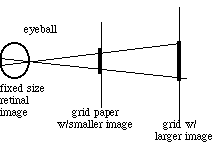
by Lori Lambertson
Exploration I. Making After Images
Materials:
To Do and Notice:
Place a small pencil dot in the center of the colored square.
Tape or place the colored square in the center of the white paper.
Place this paper on a table top, colored square facing up. Place the grid paper right next to it on the table.
Stand up, and stare directly at the dot in the center of the colored square for about 30 seconds (use the dot to help you focus). After about 30 seconds, look at the grid paper. You may need to blink to help you see an after image. What do you see?
What's Going On?
An after image of the square appears on the grid and the size of the after image is about the same size as the colored paper square. The color of the after image is different from the color of the paper square and it is predictable. Why is the after image a different color than the colored square? The retina on the back of the eye has two types of light receptors: rods and cones. Cones are responsible for color vision. Our eyes have green, red, and blue cones. When you stare at the brightly colored square, the color sensitive cones on your retina respond accordingly. If the square is red, the red cones respond. After a while, those red cones adapt to this situation and their response level changes. Then when you stare at a white sheet of paper, you see a blue-green after image of the square.
Normally, when you stare at a white sheet of paper, all three types of cones respond equally, as white light is a mix of red light, blue light, and green light, and is perceived as "white" by the brain when the red, green, and blue cones respond equally. The blue green after image is created because the red cones are temporarily adapted and respond less. The after image is seen until the cones readapt.
Going Further
II. Expanding and Shrinking After Images
Materials: in addition to the above maerials:
To Do and Notice:
Perform the after image experiment again, only this time, after you stare at the colored square on the tale top, hold the grid paper about half way between your eyes and the table top. Predict what you think you will see when you look at the after image when the grid is closer.
Stare directly at the center of the colored square for about 30 seconds. Look at the grid paper and see the after image. What happened to the after image? Are you surprised? Perform the experiment again, this time placing the grid paper on the floor (approximately doubling the distance between the colored square and the grid). What happened to the after image this time?
What's Going On?
It is counter-intuitive to move something away from our eyes and have it appear larger. In the world, when an object moves away from us, it appears to get smaller. It subtends a smaller angle on the retina. The after image is not out in the world, but is located on your retina on the back of your eye. The image gets larger as you move the grid further away and smaller when you move the grid closer. What is the relationship between the size of the image and the distance of the grid? The mathematical relationship between the size of the after images you see and the distance at which you see them can be explained using similar triangles. This is a proportional relationship: imagine two vertical angles whose shared apex is through your pupil. The image on your retina on the back of your eye is a fixed size, as is the diameter of your eyeball. We have a fixed size/distance ratio created by the image on the retina and the diameter of the eyeball. When the paper grid is twice as far from your eye as when you stared at the square, then the after image will be twice as large, covering as area four times larger than the original brightly colored square. Likewise, when the grid is placed half the distance between the distance at which the square was first viewed, the afterimage will be half the height of the original square, covering an area 1/4 that of the original square.
Side view of eyeball and the grid at two different distances (note the similar triangles drawn through the front of the eye):

Math Root
What is the Size of the Image on Your Retina?
When the afterimage fills one square inch, have a partner measure the distance from your eye to the grid in inches. Let us say this distance is 8 inches. That would mean that the image is eight times further away than it is tall. Recall that vertical angles are created as light passes through your pupil/lens. The diameter of your eye is about 1 inch, so that the image of the square is one inch away from the apex of the triangle. In this instance, the size of the image on your retina would be 1/8 inch.
This Exploration was developed by Lori Lambertson
|
Scientific Explorations with Paul Doherty |
|
3 October 2003 |